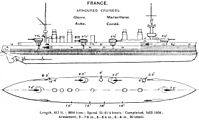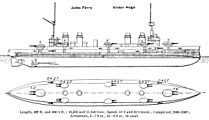Dupetit-Thouars (ship, 1901)
|
|
|
|---|---|
| Gueydon- class | |
 The Dupetit Thouars |
|
| Overview | |
| Type | Armored cruiser |
| units | 3 |
| Shipyard | |
| Keel laying | April 17, 1899 |
| Launch | July 5, 1901 |
| delivery | August 28, 1905 |
| Namesake | Aristide Aubert Dupetit-Thouars |
| Whereabouts | Sunk on August 7, 1918 |
| Technical specifications | |
| displacement |
9,500 t |
| length |
140 m waterline, |
| width |
19.5 m |
| Draft |
7 m |
| crew |
570 men |
| drive |
28 Belleville boilers , |
| speed |
21 kn |
| Range |
7,500 nm |
| Armament |
• 2 × 194 mm cannons |
| Armor |
Harvey system |
| Armored deck |
up to 160 mm |
| Belt armor |
41-152 mm |
| artillery |
up to 203 mm |
| Sister ships |
Gueydon , Montcalm |
The Dupetit-Thouars was a battleship of the French Navy , in 1901 as the third and last ship of Gueydon class from the stack running. During the First World War , the Dupetit-Thouars was sunk by U 62 while securing a convoy on August 7, 1918 in the Atlantic . The crew could be rescued up to 13 men by US destroyers .
The Dupetit-Thouars was the fourth ship named after Aristide Aubert Dupetit-Thouars (1760–1798), who died in the Battle of Abukir and had ordered the French flag to be nailed to a mast to surrender his crew to prevent.
Building history
The French Navy put sixteen large armored cruisers into service from 1902 to 1911. The first orders were for the single ship Jeanne d'Arc and the three Gueydon- class cruisers . The Dupetit-Thouars , commissioned by the Toulon naval shipyard in 1899 , was finished more slowly than its sister ships, as this shipyard had also received the order for the Jeanne d'Arc . The Dupetit-Thouars was therefore only launched on July 5, 1901 as the third and last ship of the Gueydon class, but did not enter service in the fleet until 1905. Even the launching took place after the battleships of the following Dupleix - as well as Gloire class whose eight ships all arrived at the service of her. The lead ship of the subsequent Léon Gambetta class was also put into service before her.
The heaviest armament of the cruiser was two 194 mm L / 40 cannons, model 1896, in the bow and stern individual turrets. This weapon was the heaviest of all French armored cruisers since the Dupuy de Lôme , where it was, however, placed sideways, and remained so until 1914. However, from the cruisers of the Léon Gambetta class, two twin turrets were erected, and the last two armored cruisers had even 14 of these guns.
In addition, the Gueydon class had eight 164 mm L / 45 cannons of the 1887 model and four 100 mm rapid-fire guns set up in individual casemates. Light guns and two rigid torpedo tubes on the sides completed the armament.
The ships of the Gueydon class had an armored deck of up to 150 mm thick and an equally strong belt armor made of armor plates based on the Harvey system.
The Montcalm was the first ship of the class to enter service on March 24, 1902.
Mission history
On February 17 and 18, 1905, the Dupetit-Thouars carried out a 24-hour test , which achieved an average speed of 18.92 knots. In 1911 the armored cruiser was transferred to the reserve and then reactivated in 1914 for the "division d'instruction de l'océan".
War effort
When the war broke out, the Dupetit-Thouars was assigned to the 2nd Light Squadron, which secured the canal together with British units . On October 7, 1914, she visited Lisbon . From May 1915 she was no longer used at sea and was part of the reserve in Brest . In February 1918, she transported troops to Dakar , in order to be used in convoy protection between the USA and France. It started with an overhaul in Brooklyn . On June 24, 1918, she left New York with a convoy of 28 merchant ships.
Loss of the Dupetit Thouars
On August 7, 1918, the German submarine U 62 under Kapitänleutnant Ernst Hashagen torpedoed the Dupetit-Thouars under frigate captain Paqué 400 miles west of Brest at position 46 ° 42 ' N , 12 ° 0' W . The armored cruiser sank within 50 minutes in relatively calm seas.
Six US destroyers from the flotilla stationed in Brest managed to salvage the crew of the Dupetit-Thouars up to 13 men. Were used USS Drayton (DD-23) , USS Warrington (DD-30) , USS Fanning (DD-37) (the 78 who saved), USS Winslow (DD-53) , USS Porter (DD-59) and USS Tucker (DD-57) , which was awarded by the French for its work.
The sister ships
| Fate of the ships | |||||
|---|---|---|---|---|---|
| Surname | Shipyard | Launch | in service | fate | |
| Gueydon | Arsenal, Lorient | September 20, 1899 | September 1, 1903 | 1903–1906 China, 1910 South Atlantic, 1915 Brest - Gibraltar, from 1916 Antilles and South America, 1926 training ship 1935 residential ship, converted into a dummy for the cruiser Prinz Eugen by the German Navy in 1941, sunk in August 1944 after an air raid in Brest. |
|
| Montcalm |
Forges et Chantiers de la Méditerranée , La Seyne-sur-Mer |
March 27, 1900 | March 24, 1902 | 1903–1906 China, 1910–1914 Far East and South Seas, 1915 Mediterranean, 1916–1917 Antilles, 1919 Copenhagen a. Baltic Sea, 1921–1922 Far East 1926 Housing ship, renamed Tremintin in 1934 , demolished in 1943. |
|
Plans of the armored cruisers procured at the same time
literature
- Roger Chesneau, Eugène M. Koleśnik, NJM Campbell: Conway's All the World's Fighting Ships, 1860-1905. Naval Institute Press, Annapolis, Md. 1979, ISBN 0-85177-133-5 .
- Bodo Herzog: 60 years of German submarines 1906–1966. JF Lehmanns Verlag, Munich 1968.
- John Evelyn Moore: Jane's Fighting Ships of World War I. Military Press, New York 1990.
Web links
- Access to historical plans of the Dupetit-Thouars (French, accessed May 25, 2011; PDF; 97 kB)
- croiseur Dupetit-Thouars on pages14-18 (French, accessed May 25, 2011)
- Gueydon- class (accessed May 28, 2011)
Individual evidence
- ↑ information on the 194-mm gun (Engl.)
- ↑ information on the 164-mm gun (Engl.)
- ^ Marine du Temps n ° 15958 of February 26, 1905, p. 2
- ↑ http://www.wlb-stuttgart.de/seekrieg/4108-bilder/scheinprinz.htm
- ↑ 14-18: Montcalm (French, accessed May 19, 2011)




